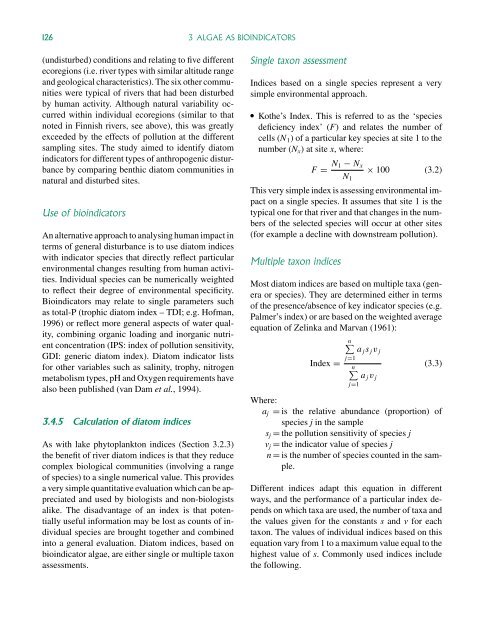Freshwater Algae: Identification and Use as Bioindicators
Freshwater Algae: Identification and Use as Bioindicators
Freshwater Algae: Identification and Use as Bioindicators
Create successful ePaper yourself
Turn your PDF publications into a flip-book with our unique Google optimized e-Paper software.
126 3 ALGAE AS BIOINDICATORS(undisturbed) conditions <strong>and</strong> relating to five differentecoregions (i.e. river types with similar altitude range<strong>and</strong> geological characteristics). The six other communitieswere typical of rivers that had been disturbedby human activity. Although natural variability occurredwithin individual ecoregions (similar to thatnoted in Finnish rivers, see above), this w<strong>as</strong> greatlyexceeded by the effects of pollution at the differentsampling sites. The study aimed to identify diatomindicators for different types of anthropogenic disturbanceby comparing benthic diatom communities innatural <strong>and</strong> disturbed sites.<strong>Use</strong> of bioindicatorsAn alternative approach to analysing human impact interms of general disturbance is to use diatom indiceswith indicator species that directly reflect particularenvironmental changes resulting from human activities.Individual species can be numerically weightedto reflect their degree of environmental specificity.<strong>Bioindicators</strong> may relate to single parameters such<strong>as</strong> total-P (trophic diatom index – TDI; e.g. Hofman,1996) or reflect more general <strong>as</strong>pects of water quality,combining organic loading <strong>and</strong> inorganic nutrientconcentration (IPS: index of pollution sensitivity,GDI: generic diatom index). Diatom indicator listsfor other variables such <strong>as</strong> salinity, trophy, nitrogenmetabolism types, pH <strong>and</strong> Oxygen requirements havealso been published (van Dam et al., 1994).3.4.5 Calculation of diatom indicesAs with lake phytoplankton indices (Section 3.2.3)the benefit of river diatom indices is that they reducecomplex biological communities (involving a rangeof species) to a single numerical value. This providesa very simple quantitative evaluation which can be appreciated<strong>and</strong> used by biologists <strong>and</strong> non-biologistsalike. The disadvantage of an index is that potentiallyuseful information may be lost <strong>as</strong> counts of individualspecies are brought together <strong>and</strong> combinedinto a general evaluation. Diatom indices, b<strong>as</strong>ed onbioindicator algae, are either single or multiple taxon<strong>as</strong>sessments.Single taxon <strong>as</strong>sessmentIndices b<strong>as</strong>ed on a single species represent a verysimple environmental approach. Kothe’s Index. This is referred to <strong>as</strong> the ‘speciesdeficiency index’ (F) <strong>and</strong> relates the number ofcells (N 1 ) of a particular key species at site 1 to thenumber (N x ) at site x, where:F = N 1 − N x× 100 (3.2)N 1This very simple index is <strong>as</strong>sessing environmental impacton a single species. It <strong>as</strong>sumes that site 1 is thetypical one for that river <strong>and</strong> that changes in the numbersof the selected species will occur at other sites(for example a decline with downstream pollution).Multiple taxon indicesMost diatom indices are b<strong>as</strong>ed on multiple taxa (generaor species). They are determined either in termsof the presence/absence of key indicator species (e.g.Palmer’s index) or are b<strong>as</strong>ed on the weighted averageequation of Zelinka <strong>and</strong> Marvan (1961):n∑a j s j v jj=1Index =(3.3)n∑a j v jj=1Where:a j = is the relative abundance (proportion) ofspecies j in the samples j = the pollution sensitivity of species jv j = the indicator value of species jn = is the number of species counted in the sample.Different indices adapt this equation in differentways, <strong>and</strong> the performance of a particular index dependson which taxa are used, the number of taxa <strong>and</strong>the values given for the constants s <strong>and</strong> v for eachtaxon. The values of individual indices b<strong>as</strong>ed on thisequation vary from 1 to a maximum value equal to thehighest value of s. Commonly used indices includethe following.
















